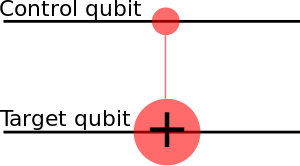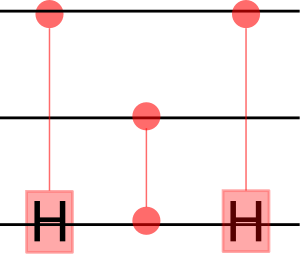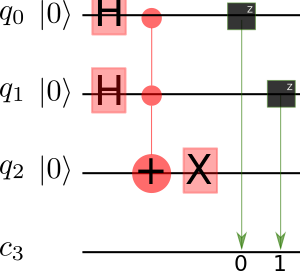Quantum Gates: Difference between revisions
| (35 intermediate revisions by the same user not shown) | |||
| Line 4: | Line 4: | ||
<syntaxhighlight> | <syntaxhighlight> | ||
from qiskit import QuantumCircuit, execute, Aer | from qiskit import QuantumCircuit, execute, Aer | ||
from qiskit import QuantumRegister, ClassicalRegister #The newer version uses Registers | |||
from qiskit.visualization import plot_histogram, plot_bloch_vector | from qiskit.visualization import plot_histogram, plot_bloch_vector | ||
from math import pi | |||
</syntaxhighlight> | </syntaxhighlight> | ||
<syntaxhighlight> | |||
a = 0 | |||
b = 1 | |||
t = 2 | |||
</syntaxhighlight> | |||
Plot the quantum circuit | Plot the quantum circuit | ||
<syntaxhighlight> | <syntaxhighlight> | ||
qc.draw('mpl') | qc.draw('mpl') | ||
#qc.draw('latex') | |||
#qc.draw('latex_source') | |||
</syntaxhighlight> | </syntaxhighlight> | ||
| Line 18: | Line 31: | ||
qc.draw() | qc.draw() | ||
result = execute(qc,backend).result() #.get_statevector() #.get_counts() | result = execute(qc,backend).result() #.get_statevector() #.get_counts() | ||
plot_bloch_multivector(result) | |||
counts = result.get_counts() | counts = result.get_counts() | ||
plot_histogram(counts) | plot_histogram(counts) | ||
</syntaxhighlight> | </syntaxhighlight> | ||
== Quantum Gates of One Qubit == | == Theory == | ||
=== Quantum Gates of One Qubit === | |||
There are only two reversible gates, also ''identity'' (return the input unchanged) and NOT (return the opposite of the input), but neither is universal. | There are only two reversible gates, also ''identity'' (return the input unchanged) and NOT (return the opposite of the input), but neither is universal. | ||
| Line 69: | Line 86: | ||
</syntaxhighlight> | </syntaxhighlight> | ||
== Two Qubit Quantum Gates == | === Two Qubit Quantum Gates === | ||
The reversibel gates are eg. ''identity'', or CNOT. | The reversibel gates are eg. ''identity'', or CNOT. | ||
| Line 118: | Line 135: | ||
\end{bmatrix} | \end{bmatrix} | ||
</math> | </math> | ||
<gallery> | |||
ControlledH.png|Controlled H | |||
ControlledY.png|Controlled Y | |||
ControlledZ.png|Controlled Z | |||
</gallery> | |||
Controlled-Z. Because <math>H X H = Z</math> and <math>H Z H = X</math> we can write | Controlled-Z. Because <math>H X H = Z</math> and <math>H Z H = X</math> we can write | ||
| Line 124: | Line 147: | ||
qc = QuantumCircuit(2) | qc = QuantumCircuit(2) | ||
# also a controlled-Z | # also a controlled-Z | ||
qc.h( | qc.h(1) | ||
qc.cx( | qc.cx(0,1) | ||
qc.h( | qc.h(1) | ||
</syntaxhighlight> | </syntaxhighlight> | ||
| Line 135: | Line 157: | ||
qc = QuantumCircuit(2) | qc = QuantumCircuit(2) | ||
# a controlled-Y | # a controlled-Y | ||
qc.sdg( | qc.sdg(1) | ||
qc.cx( | qc.cx(0,1) | ||
qc.s( | qc.s(1) | ||
</syntaxhighlight> | </syntaxhighlight> | ||
| Line 146: | Line 167: | ||
qc = QuantumCircuit(2) | qc = QuantumCircuit(2) | ||
# a controlled-H | # a controlled-H | ||
qc.ry(pi/4, | qc.ry(pi/4,1) | ||
qc.cx( | qc.cx(0,1) | ||
qc.ry(-pi/4, | qc.ry(-pi/4,1) | ||
</syntaxhighlight> | </syntaxhighlight> | ||
Swap gate | Swap gate: CNOT. | ||
An arbitrary controlled-controlled-U for any single-qubit rotation U. We need <math>V = \sqrt U</math> and <math>V^\dagger</math> | An arbitrary controlled-controlled-U for any single-qubit rotation U. We need <math>V = \sqrt U</math> and <math>V^\dagger</math> | ||
| Line 165: | Line 185: | ||
qc.cx(a,b) | qc.cx(a,b) | ||
qc.cu1(theta,a,t) | qc.cu1(theta,a,t) | ||
</syntaxhighlight> | </syntaxhighlight> | ||
== Three | === Three Qubit Gates === | ||
[[File:Toffoli.svg|thumb|Toffoli gate made using CNOTs.]] | [[File:Toffoli.svg|thumb|Toffoli gate made using CNOTs.]] | ||
| Line 179: | Line 198: | ||
<syntaxhighlight> | <syntaxhighlight> | ||
qc = QuantumCircuit(3) | qc = QuantumCircuit(3) | ||
# Toffoli with control qubits a and b and target t | # Toffoli with control qubits a and b and target t | ||
qc.ccx(a,b,t) | qc.ccx(a,b,t) | ||
</syntaxhighlight> | </syntaxhighlight> | ||
| Line 194: | Line 209: | ||
qc.cz(b,t) | qc.cz(b,t) | ||
qc.ch(a,t) | qc.ch(a,t) | ||
</syntaxhighlight> | </syntaxhighlight> | ||
| Line 205: | Line 219: | ||
NAND gate is | NAND gate is | ||
== Multiple Controlled Toffoli == | |||
<syntaxhighlight> | |||
mct() | |||
</syntaxhighlight> | |||
== Logical Gates == | |||
The gates must be reversible. | |||
=== Not Gate === | |||
The X gate is a not gate, and is reversible. | |||
=== And Gate === | |||
The classical And mixes the inputs, thus we need two inputs. The Toffoli gate will do | |||
<syntaxhighlight> | |||
qc.ccx(q[0], q[1], q[2]) | |||
</syntaxhighlight> | |||
=== Nand Gate === | |||
The Nand Gate is easy after the And gate. Just apply the Not gate. | |||
<syntaxhighlight> | |||
qc.ccx(q[0], q[1], q[2]) | |||
qc.x(q[2]) | |||
</syntaxhighlight> | |||
=== Xor gate === | |||
Or gate is true only if either of inputs is true. Thus we have: | |||
<syntaxhighlight> | |||
qc.cx(q[1], q[2]) | |||
qc.cx(q[0], q[2]) | |||
</syntaxhighlight> | |||
=== Or Gate === | |||
The Or gate is true if either is true, thus first check the nots and then toffoli (and): | |||
<syntaxhighlight> | |||
qc.cx(q[0], q[2]) | |||
qc.cx(q[1], q[2]) | |||
qc.ccx(q[0], q[1], q[2]) | |||
</syntaxhighlight> | |||
=== Nor Gate === | |||
The Nor gate is the negation of Or gate: | |||
<syntaxhighlight> | |||
qc.cx(q[0], q[2]) | |||
qc.cx(q[1], q[2]) | |||
qc.ccx(q[0], q[1], q[2]) | |||
qc.x(q[2]) | |||
</syntaxhighlight> | |||
== Half Adder --- Results == | |||
<syntaxhighlight> | |||
qc.initialize([1,0], 0) | |||
qc.initialize([1,0], 1) | |||
print(count) | |||
-> {'00': 1000} | |||
</syntaxhighlight> | |||
<syntaxhighlight> | |||
qc.initialize([1,0], 0) | |||
qc.initialize([0,1], 1) | |||
-> {'01': 1000} | |||
</syntaxhighlight> | |||
<syntaxhighlight> | |||
qc.initialize([0,1], 0) | |||
qc.initialize([1,0], 1) | |||
-> {'01': 1000} | |||
</syntaxhighlight> | |||
<syntaxhighlight> | |||
qc.initialize([0,1], 0) | |||
qc.initialize([0,1], 1) | |||
-> {'10': 1000} | |||
</syntaxhighlight> | |||
== Full Adder == | |||
The state is initialized to <math>|0\rangle</math>, thus to set it to <math>|1\rangle</math> we may initialize it or use X Gate. | |||
<syntaxhighlight> | |||
##Define registers and a quantum circuit | |||
q = QuantumRegister(4) | |||
c = ClassicalRegister(2) | |||
qc = QuantumCircuit(q,c) | |||
# | |||
#qc.initialize([1,0], 0) | |||
#qc.initialize([0,1], 1) | |||
#qc.initialize([1,0], 2) | |||
qc.x(q[0]) | |||
qc.x(q[2]) | |||
##AND -- carry | |||
qc.ccx(q[0], q[1], q[3]) | |||
qc.cx(q[0], q[1]) | |||
qc.ccx(q[1], q[2], q[3]) | |||
qc.cx(q[1], q[2]) | |||
qc.cx(q[0], q[1]) | |||
##Sum | |||
qc.measure(q[2], c[0]) | |||
##Carry out | |||
qc.measure(q[3], c[1]) | |||
</syntaxhighlight> | |||
''Oops 😕! Result did not match expected values | |||
Please review your answer and try again.:'' | |||
<syntaxhighlight> | |||
from qiskit import QuantumRegister, ClassicalRegister, QuantumCircuit | |||
from qiskit import IBMQ, Aer, execute | |||
##Define registers and a quantum circuit | |||
q = QuantumRegister(5) | |||
c = ClassicalRegister(2) | |||
qc = QuantumCircuit(q,c) | |||
# | |||
qc.initialize([1,0], 0) | |||
qc.initialize([0,0], 1) | |||
qc.initialize([1,0], 2) | |||
##AND -- carry | |||
qc.ccx(q[0], q[1], q[4]) | |||
qc.ccx(q[0], q[2], q[4]) | |||
qc.ccx(q[1], q[2], q[4]) | |||
qc.barrier() | |||
##XOR - sum | |||
qc.cx(q[0], q[3]) | |||
qc.cx(q[1], q[3]) | |||
qc.cx(q[2], q[3]) | |||
qc.barrier() | |||
emulator = Aer.get_backend('qasm_simulator') | |||
job = execute(qc, emulator, shots=2048 ) | |||
hist = job.result().get_counts() | |||
plot_histogram(hist) | |||
##Sum | |||
qc.measure(q[3], c[0]) | |||
##Carry out | |||
qc.measure(q[4], c[1]) | |||
backend = Aer.get_backend('qasm_simulator') | |||
job = execute(qc, backend, shots=1000) | |||
result = job.result() | |||
count =result.get_counts() | |||
print(count) | |||
qc.draw(output='mpl') | |||
</syntaxhighlight> | |||
=== Results === | |||
Results for the second case: | |||
<syntaxhighlight> | |||
qc.initialize([0,1], 0) | |||
qc.initialize([0,1], 1) | |||
qc.initialize([0,1], 2) | |||
-> {'11': 1000} | |||
</syntaxhighlight> | |||
<syntaxhighlight> | |||
qc.initialize([0,1], 0) | |||
qc.initialize([0,1], 1) | |||
qc.initialize([1,0], 2) | |||
-> {'10': 1000} | |||
</syntaxhighlight> | |||
<syntaxhighlight> | |||
qc.initialize([0,1], 0) | |||
qc.initialize([1,0], 1) | |||
qc.initialize([0,1], 2) | |||
-> {'10': 1000} | |||
</syntaxhighlight> | |||
<syntaxhighlight> | |||
qc.initialize([0,1], 0) | |||
qc.initialize([1,0], 1) | |||
qc.initialize([1,0], 2) | |||
-> {'01': 1000} | |||
</syntaxhighlight> | |||
<syntaxhighlight> | |||
qc.initialize([1,0], 0) | |||
qc.initialize([0,1], 1) | |||
qc.initialize([0,1], 2) | |||
-> {'10': 1000} | |||
</syntaxhighlight> | |||
<syntaxhighlight> | |||
qc.initialize([1,0], 0) | |||
qc.initialize([0,1], 1) | |||
qc.initialize([1,0], 2) | |||
-> {'01': 1000} | |||
</syntaxhighlight> | |||
<syntaxhighlight> | |||
qc.initialize([1,0], 0) | |||
qc.initialize([1,0], 1) | |||
qc.initialize([0,1], 2) | |||
-> {'01': 1000} | |||
</syntaxhighlight> | |||
<syntaxhighlight> | |||
qc.initialize([1,0], 0) | |||
qc.initialize([1,0], 1) | |||
qc.initialize([1,0], 2) | |||
-> {'00': 1000} | |||
</syntaxhighlight> | |||
=== References === | |||
https://www.quantum-inspire.com/kbase/full-adder/ | |||
https://lahirumadushankablog.wordpress.com/2020/02/04/quantum-half-adder-and-full-adder/ | |||
https://agentanakinai.wordpress.com/2019/08/31/quantum-full-adder/ | |||
https://medium.com/@sashwat.anagolum/arithmetic-on-quantum-computers-addition-7e0d700f53ae | |||
https://docs.microsoft.com/en-us/quantum/user-guide/libraries/standard/algorithms | |||
Latest revision as of 19:43, 29 November 2020
Introduction
Import the modules
from qiskit import QuantumCircuit, execute, Aer
from qiskit import QuantumRegister, ClassicalRegister #The newer version uses Registers
from qiskit.visualization import plot_histogram, plot_bloch_vector
from math import pia = 0
b = 1
t = 2
Plot the quantum circuit
qc.draw('mpl')
#qc.draw('latex')
#qc.draw('latex_source')Plot the results
backend = Aer.get_backend('statevector_simulator') # Tell Qiskit how to simulate our circuit
qc.measure_all()
qc.draw()
result = execute(qc,backend).result() #.get_statevector() #.get_counts()
plot_bloch_multivector(result)
counts = result.get_counts()
plot_histogram(counts)Theory
Quantum Gates of One Qubit
There are only two reversible gates, also identity (return the input unchanged) and NOT (return the opposite of the input), but neither is universal.
Identity gate.
Pauli X gate.
Pauli Y gate
Pauli Z gate
R gate
S gate or gate
T gate
U1 gate:
U2 gate:
qc = QuantumCircuit(1)
qc.x(0)
#qc.y(0) # Y-gate on qubit 0
#qc.z(0) # Z-gate on qubit 0
#qc.rz(pi/4, 0)
#qc.s(0) # Apply S-gate to qubit 0
#qc.sdg(0) # Apply Sdg-gate to qubit 0
qc.t(0) # Apply T-gate to qubit 0
qc.tdg(0) # Apply Tdg-gate to qubit 0Two Qubit Quantum Gates
The reversibel gates are eg. identity, or CNOT.
Eg. .

Eg. CNOT is a conditional gate that performs an X-gate on the second qubit, if the state of the first qubit (control) is . . This matrix swaps the amplitudes of |01⟩ and |11⟩ in the statevector. .
CNOT if a control qubit is on the superposition:
, which is Bell State. Entanglement, but no-communication theorem.
. Unchanged.
.
. Affects the state of the control qubit, only.
qc = QuantumCircuit(2)
qc.h(0) # Apply H-gate to the first:
qc.cx(0,1) # Apply a CNOT:
Any controlled quantum gate is and in Qiskit formalism is written in matrix as
-
Controlled H
-
Controlled Y
-
Controlled Z
Controlled-Z. Because Failed to parse (SVG (MathML can be enabled via browser plugin): Invalid response ("Math extension cannot connect to Restbase.") from server "https://wikimedia.org/api/rest_v1/":): {\displaystyle H X H = Z} and we can write
qc = QuantumCircuit(2)
# also a controlled-Z
qc.h(1)
qc.cx(0,1)
qc.h(1)Controlled-Y is
qc = QuantumCircuit(2)
# a controlled-Y
qc.sdg(1)
qc.cx(0,1)
qc.s(1)or Controlled-H is
qc = QuantumCircuit(2)
# a controlled-H
qc.ry(pi/4,1)
qc.cx(0,1)
qc.ry(-pi/4,1)Swap gate: CNOT.
An arbitrary controlled-controlled-U for any single-qubit rotation U. We need and
#The controls are qubits a and b, and the target is qubit t.
#Subroutines cu1(theta,c,t) and cu1(-theta,c,t) need to be defined
qc = QuantumCircuit(3)
qc.cu1(theta,b,t)
qc.cx(a,b)
qc.cu1(-theta,b,t)
qc.cx(a,b)
qc.cu1(theta,a,t)Three Qubit Gates

For universal computations we need more qubits. Eg. the AND gate is not reversible, and thus we need eg. Toffoli (CCNOT) gate.
Toffoli gate performs on target qubit if both control cubits are set to state .
qc = QuantumCircuit(3)
# Toffoli with control qubits a and b and target t
qc.ccx(a,b,t)
Toffoli using CNOTs uses fewer gates.
qc = QuantumCircuit(3)
qc.ch(a,t)
qc.cz(b,t)
qc.ch(a,t)AND gate is Toffoli gate with . . .

gives the reversible NAND
NAND gate is
Multiple Controlled Toffoli
mct()Logical Gates
The gates must be reversible.
Not Gate
The X gate is a not gate, and is reversible.
And Gate
The classical And mixes the inputs, thus we need two inputs. The Toffoli gate will do
qc.ccx(q[0], q[1], q[2])Nand Gate
The Nand Gate is easy after the And gate. Just apply the Not gate.
qc.ccx(q[0], q[1], q[2])
qc.x(q[2])Xor gate
Or gate is true only if either of inputs is true. Thus we have:
qc.cx(q[1], q[2])
qc.cx(q[0], q[2])Or Gate
The Or gate is true if either is true, thus first check the nots and then toffoli (and):
qc.cx(q[0], q[2])
qc.cx(q[1], q[2])
qc.ccx(q[0], q[1], q[2])Nor Gate
The Nor gate is the negation of Or gate:
qc.cx(q[0], q[2])
qc.cx(q[1], q[2])
qc.ccx(q[0], q[1], q[2])
qc.x(q[2])Half Adder --- Results
qc.initialize([1,0], 0)
qc.initialize([1,0], 1)
print(count)
-> {'00': 1000}qc.initialize([1,0], 0)
qc.initialize([0,1], 1)
-> {'01': 1000}qc.initialize([0,1], 0)
qc.initialize([1,0], 1)
-> {'01': 1000}qc.initialize([0,1], 0)
qc.initialize([0,1], 1)
-> {'10': 1000}
Full Adder
The state is initialized to , thus to set it to we may initialize it or use X Gate.
##Define registers and a quantum circuit
q = QuantumRegister(4)
c = ClassicalRegister(2)
qc = QuantumCircuit(q,c)
#
#qc.initialize([1,0], 0)
#qc.initialize([0,1], 1)
#qc.initialize([1,0], 2)
qc.x(q[0])
qc.x(q[2])
##AND -- carry
qc.ccx(q[0], q[1], q[3])
qc.cx(q[0], q[1])
qc.ccx(q[1], q[2], q[3])
qc.cx(q[1], q[2])
qc.cx(q[0], q[1])
##Sum
qc.measure(q[2], c[0])
##Carry out
qc.measure(q[3], c[1])Oops 😕! Result did not match expected values Please review your answer and try again.:
from qiskit import QuantumRegister, ClassicalRegister, QuantumCircuit
from qiskit import IBMQ, Aer, execute
##Define registers and a quantum circuit
q = QuantumRegister(5)
c = ClassicalRegister(2)
qc = QuantumCircuit(q,c)
#
qc.initialize([1,0], 0)
qc.initialize([0,0], 1)
qc.initialize([1,0], 2)
##AND -- carry
qc.ccx(q[0], q[1], q[4])
qc.ccx(q[0], q[2], q[4])
qc.ccx(q[1], q[2], q[4])
qc.barrier()
##XOR - sum
qc.cx(q[0], q[3])
qc.cx(q[1], q[3])
qc.cx(q[2], q[3])
qc.barrier()
emulator = Aer.get_backend('qasm_simulator')
job = execute(qc, emulator, shots=2048 )
hist = job.result().get_counts()
plot_histogram(hist)
##Sum
qc.measure(q[3], c[0])
##Carry out
qc.measure(q[4], c[1])
backend = Aer.get_backend('qasm_simulator')
job = execute(qc, backend, shots=1000)
result = job.result()
count =result.get_counts()
print(count)
qc.draw(output='mpl')
Results
Results for the second case:
qc.initialize([0,1], 0)
qc.initialize([0,1], 1)
qc.initialize([0,1], 2)
-> {'11': 1000}qc.initialize([0,1], 0)
qc.initialize([0,1], 1)
qc.initialize([1,0], 2)
-> {'10': 1000}qc.initialize([0,1], 0)
qc.initialize([1,0], 1)
qc.initialize([0,1], 2)
-> {'10': 1000}qc.initialize([0,1], 0)
qc.initialize([1,0], 1)
qc.initialize([1,0], 2)
-> {'01': 1000}qc.initialize([1,0], 0)
qc.initialize([0,1], 1)
qc.initialize([0,1], 2)
-> {'10': 1000}qc.initialize([1,0], 0)
qc.initialize([0,1], 1)
qc.initialize([1,0], 2)
-> {'01': 1000}qc.initialize([1,0], 0)
qc.initialize([1,0], 1)
qc.initialize([0,1], 2)
-> {'01': 1000}qc.initialize([1,0], 0)
qc.initialize([1,0], 1)
qc.initialize([1,0], 2)
-> {'00': 1000}References
https://www.quantum-inspire.com/kbase/full-adder/
https://lahirumadushankablog.wordpress.com/2020/02/04/quantum-half-adder-and-full-adder/
https://agentanakinai.wordpress.com/2019/08/31/quantum-full-adder/
https://medium.com/@sashwat.anagolum/arithmetic-on-quantum-computers-addition-7e0d700f53ae
https://docs.microsoft.com/en-us/quantum/user-guide/libraries/standard/algorithms
































